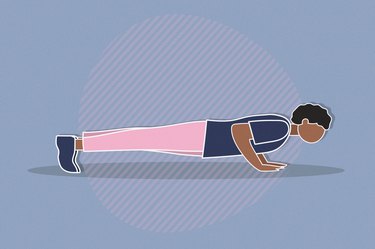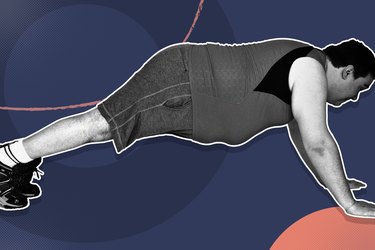
If any single exercise draws universal applause, it's the push-up. While it would be somewhat misleading to call it the complete exercise, it comes pretty close. And because there are so many benefits of push-ups, many exercisers wonder if doing daily push-ups is even better.
Doing 30 push-ups a day for a month (or longer) can improve your strength. But you'll only get so far before you plateau and will need to vary your routine. Plus, without any rest days, you could experience a disadvantage of daily push-ups: overtraining. Keep reading for a look at the pros and cons of daily push-ups and how often to do push-ups.
Video of the Day
Video of the Day
Is It Safe to Do 30 Push-Ups Every Day?
While it's important to vary your workouts (more on that below), a daily push-up routine can still be safe and effective, as long as you're doing your push-ups with good form.
How to Do a Perfect Push-Up
- Plant your hands on the floor about shoulder-distance apart. Your shoulders should be stacked over your wrists and your hips should be in line with your head and heels. Engage your core and glutes.
- Bend your elbows at a 45-degree angle from your torso, rather than allowing them to flare out to the sides, and lower your body toward the ground.
- On the way down, squeeze your shoulder blades together.
- When your chest hovers just above the ground (or however far down you can go), press into your palms and push your shoulder blades apart to return to the starting position.
- Keep your trunk stable and straight as you push up and down. This means no hiking of the hips or sagging into the lower back, which puts your shoulders, elbows and back at risk of injury.
Benefits of Doing 30 Push-Ups Every Day
You'll Gain Upper-Body Strength
While your arms do the actual pushing when you lift your body off the ground, they set off a chain reaction of muscle activation. In addition to your biceps and triceps, push-ups also work your shoulder and chest muscles.
Thirty push-ups a day will build your chest, add definition to your arms and increase your muscle mass. It's real-life upper body strength, too, facilitating movements that range from carrying in the groceries to pushing a lawnmower.
You'll Strengthen Your Core
While push-ups do activate the rectus abdominus — the sheath of abdominal muscle where the "six-pack abs" live — they can do even more for true core strength and stability by stimulating the transverse abdominus.
That's the most deep-set of the abdominal muscles. When it's weak, it can lead to issues with your gait and balance and even contribute to lower back pain. To maximize this benefit, be sure to "brace" your abdominal area as if somebody who doesn't like you is about to punch you in the stomach. Hold that tension throughout the push-up.
Your Posture Will Improve
Thirty push-ups a day are likely to do wonders for poor posture by stabilizing and strengthening the muscles that attach to the clavicle. This includes the pectoralis major. Push-ups correct weakness and offset shortening of the pectoralis minor that leads to rounded shoulders.
Your Back Pain May Ease
In addition to stabilizing the scapulae by working the muscles that attach to the shoulder blades and clavicle, your 30 daily push-ups will activate the erector spinae muscles in your lumbar spine.
These are the muscles that keep your hips from sagging. When they're weak, they can contribute to lower back pain. Keeping your glutes engaged and your legs active from your thighs down to your toes will further stabilize your lower back.
Your Balance May Improve
The pushing motion that is the essence of the push-up mimics what we do when we're trying to break a fall. Having the strength to reach out and push back from walls, doors or floors is great insurance against injury, particularly for older adults, according to Harvard Health Publishing.
Drawbacks of Doing 30 Push-Ups Every Day
You'll Plateau
Muscle development requires putting progressively greater stress on the muscle during exercise, called progressive overload. In other words, once your muscles respond to a certain level of activation, they put themselves on cruise control.
Keep doing your 30 push-ups every day and you'll maintain the strength you've gained, but at a certain point the curve flattens out.
How to Avoid Plateauing
You'll need to strategically tweak your push-up frequency, reps or form. For example, you could incorporate some push-up variations into your routine to work your upper-body muscles from different angles. You could increase how many push-ups you do daily from 30 to 40 and then even more over time. Or you could sprinkle in some rest days from push-ups to do upper-body exercises with weights.
You Could Overtrain Certain Muscles and Undertrain Others
Lots of push-ups without exercises to strengthen the upper back muscles could be counter-productive, leading to what's called a muscle imbalance. This overtraining of the front of your upper body and undertraining of the back of your upper body could lead to worsening posture or pain. It's important to strengthen and stretch your upper back muscles regularly if you're doing push-ups every day, according to the Mayo Clinic.
How to Do Push-Ups Every Day Safely
Ideally, you'd give yourself some days off rather than doing push-ups every day. This gives your upper-body muscles time to recover and allows you an opportunity to focus on other exercises and muscle groups.
If you do want to try a daily pushup challenge, make sure you're using proper form. Start off with only as many reps as you can safely and comfortably complete before jumping right in to 30 push-ups a day. Over time, you can start doing more reps each day.
If daily push-ups have grown too easy, you can make things more challenging by trying push-up variations or by taking a break from push-ups and try other upper-body exercises that can help you keep progressing toward your fitness goals like a chest press or bench press.
Was this article helpful?
150 Characters Max
0/150
Thank you for sharing!
Thank you for your feedback!


